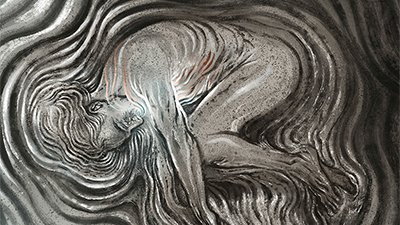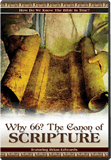
How the Apostle Peter Relates to the Age of the Earth Debate
Analyzing 2 Peter 3:1–7
The Apostle Peter and Genesis
When it comes to the discussion over the days of creation and the age of the earth, many people mistakenly think that the issue only involves the interpretation of the early chapters of Genesis. However, it is important to remember that the teachings of the New Testament are also significant to this debate.
Second Peter 3:1–7, for example, says that in the last days scoffers will come scoffing at the belief that Christ will come again. They will base their ideas upon the assumption that the world has not changed, deliberately ignoring two major events in the history of world: God’s supernatural Creation of the world and God’s judgment of the world by the historical, global, catastrophic Flood in the days of Noah.
Peter’s understanding of these two events is key as it helps us see how the apostle read Genesis. This in turn informs our understanding of the issue of the earth’s age. It is important then to consider what these verses say.
Beloved, I now write to you this second epistle (in both of which I stir up your pure minds by way of reminder), that you may be mindful of the words which were spoken before by the holy prophets, and of the commandment of us, the apostles of the Lord and Savior, . . . (2 Peter 3:1–2)
Peter1 is writing the letter to stir up believers concerning false teaching (2:1), by way of reminder (see 1:13), calling his readers to remember the words previously spoken by the holy prophets and the commandment of the Lord Jesus spoken by the apostles. The reason we can trust the prophetic Word over and against the false teachers is that it was given by the Holy Spirit as He moved men to speak from God in the writing of Scripture (1:19–21).
. . . knowing this first: that scoffers will come in the last days, walking according to their own lusts, . . . (2 Peter 3:3)
Peter’s priority is to warn his readers to be mindful of the coming false teachers’ attacks. The term “knowing this first” is not referring to the first in the list of things; rather it means the first in priority. The priority for Peter is to alert his readers to the presence of the coming scoffers, which is a sign that the last days have arrived. The “last days” are a reference to the era from Christ’s first coming until His return (Acts 2:17; 2 Timothy 3:1). Peter’s readers should recognize that scoffers will come in the last days, scoffing after their own lusts. What is the motivation of the scoffers? Immorality. Peter uses the Greek word epithumia to encapsulate the scoffers’ ungodly sexual desires (see 2:10, 18).
. . . and saying, “Where is the promise of His coming? For since the fathers fell asleep, all things continue as they were from the beginning of creation.” (2 Peter 3:4)
Peter points out that the scoffers come ridiculing the idea of the future coming of Jesus Christ in judgment and salvation. They deny the second coming of Christ not because of their intellect, but because it fits their immorality since they do not want to be held accountable for their sin. Today atheists and agnostics scoff at the belief in the return of Christ; however, atheism and agnosticism have nothing to do with the evidence (see Romans 1:18–20) but are simply tools for sinners to indulge in their own lusts.2
Scoffing is argument by ridicule which continues to this day. Those who scoff at Christianity often ridicule believers who accept the idea of divine Creation and God’s judgment by a global Flood by calling them “fundamentalists,” “anti-intellectuals,” and “literalists.” This sort of argument (epithet fallacies) is meant to capitalize on people’s emotions.
As well as being motivated by their immorality, the mockers base their arguments on the idea that “all things continue as they were from the beginning of creation” (2 Peter 3:4); this is equivalent to the modern idea of uniformitarianism. The phrase “the beginning of creation,” (ἀπ᾽ ἀρχῆς κτίσεως) as in other New Testament texts (Mark 10:6; 1 John 1:1, 2:13–14), is referring to the beginning of creation and not merely the beginning of the human race.3 The creation reference here is important as Peter picks it up in verses 5–6.
God’s revelation, and not the present, is the key to understanding the past.
In the modern era, the argument for uniformitarianism4 was popularized by Charles Lyell in his book The Principles of Geology. This idea assumes that the processes we observe in our present world are the way they have always been (based on the religion of naturalism). This is a common assumption among old-earth creationists (who borrow this from the naturalistic religion). However, if conditions have not always been the same as we observe today or at the same rate, then this philosophy fails, as does the idea of an old earth and universe. God’s revelation, and not the present, is the key to understanding the past.
Uniformitarianism has nothing to do with observation or the evidence, but scoffers believe it to avoid interpreting catastrophic processes such as Noah’s Flood.5 Accepting that the world has not always operated under uniformitarian assumptions also informs our understanding of the age of the earth. The reason that different dating methods sometimes give long ages is that they start with the same assumptions:
- The decay rate has stayed constant.
- The initial conditions are known.
- The amount of parent and daughter element is known to have not been altered by other processes in the past.
However, our starting point for any dating method is either a history position that God has revealed to us or a faith position about the past. The history position that God has revealed to us includes some of the details of what the early earth was like and how it has changed (i.e. a very good Creation [Genesis 1:31], the Fall [Genesis 3; Romans 5:12], and the global Flood [Genesis 6–8]). The faith position states that whatever processes are doing now is what they have always been doing; i.e., the present is the key to the past. The starting position for the age of the earth is a choice between faith in the God who was there or the opinion of men who were not.
The scoffers’ argument is that, since the fathers (Old Testament patriarchs)6 fell asleep (a euphemism for death), nothing has changed since the beginning of creation; in other words, there has been no supernatural intervention. The scoffers denied, and Peter affirmed, the promise of eschatological judgment that is found within the Old Testament. Peter’s opponents, in essence, are denying any divine intervention in human affairs while at the same time twisting the Old Testament Scriptures.
The scoffers’ rational for rejecting Christ’s coming and future judgment is a lack of divine intervention in human affairs in the past, starting with the Creation and the Flood.
For this they willfully forget: that by the word of God the heavens were of old, and the earth standing out of water and in the water, by which the world that then existed perished, being flooded with water. (2 Peter 3:5–6)
The scoffers of Peter’s day are very much like modern day sceptics in that they “willfully forget” the facts of biblical history. The scoffers, Peter suggests, “are not ignorant or naive, but willfully disobedient, maintaining a view of the continuity of human history that blatantly flies in the face of the Old Testament.”7
The reference to heavens and earth is a clear reference back to the creation account in Genesis. There are two particular events of biblical history that the scoffers “willfully forget”:
- The original creation of the heavens and earth that existed by the Word of God and was formed out of water and by water (see Genesis 1:1–2).
- The cataclysmic global Flood with which God previously judged the world (Genesis 6–8).
These two events are significant when it comes to understanding the age of the earth.
Peter states that it was the Word of God that brought the heavens and earth into existence. Genesis 1:3–30 repeatedly states, “And God said . . .” and then notes the event that happened immediately within the confines of the context of a 24-hour day:
Narration: “God said . . .”
Commandment: “let there be . . .”
Fulfillment: “there was”
Evaluation: “God saw that it was good”
And conclusion: “there was evening and morning”
In the context of Genesis 1, the divine command “Let there be” is a jussive form of the verb, which is followed by “and it was so,” which reveals rapid fulfilment of that command with no process. This is confirmed by the rest of Scripture (Psalm 33:6, 9, 148:1–6).
The New Testament further attests to this by God who spoke through His Son, the Word, to create the world (e.g., John 1:1–3; Colossians 1:16; Hebrews 1:2). When He became a man, Jesus’ first recorded miracle revealed His glory as the Creator, when He turned water into wine (John 2:1–11). We see the instant nature of His miracles very clearly in His encounter with the Roman centurion in Matthew 8:5–13 where the centurion’s servant was healed the very moment Jesus commanded it. In fact, His miracles were ordinarily instantaneous (e.g., Mark 10:52; Luke 18:42–43).
Since God is the Creator of time, He does not need time to create.
Hebrews 11:3 also affirms that the world was made by “the word of God.” The author of Hebrews has in mind the divine command, “Let there be light” (Genesis 1:3), interpreting it in the fashion of Psalm 33:6, 9.8 So when Jesus, the Word, spoke the divine command, “Let there be light” (Genesis 1:3), we have very good reasons to conclude that it did not take millions of years for it to come into existence. Since God is the Creator of time, He does not need time to create. In fact Scripture tells us why God took so long to create (see Exodus 20:11, 31:17).
As with many Christian pastors and teachers today, it escaped the scoffers’ notice that God created the world not only by His Word, but out of water and by water. The reference that the earth was formed out of water and by water is an indication that Peter clearly understood Genesis as straightforward, historical narrative according to the plain sense of the text. Peter’s understanding of Genesis is important, as Genesis makes it clear that the world was covered with water on Days One and Two. However, secular cosmology of the world has the earth starting out as a molten blob.

Peter goes on to say that the water of creation was used in the destruction of that same world. Given that Peter is following the Genesis narrative, the water he refers to that destroyed the world is probably a reference to the water mentioned in Genesis 7:11: the fountains of the great deep and the windows of heaven. “What was destroyed was ‘the world at that time,’ which contrasts with ‘present heavens and earth’ that are mentioned in . . . verse [7].”9 The Flood not only destroyed human life that inhabited the world at that time (2:5), but it also affected the entire physical world (Genesis 6:13). Therefore Peter, by reminding his readers of the Flood, “cuts the heart out of the heretics’ [scoffers] claim that ‘all things remain as they were from the beginning of creation.’”10
The word Peter uses for flood sheds light on the nature of the Flood. It is the Greek word katakluzō (3:6) from which we derive our English word cataclysm—a clear reference to a global catastrophe (Luke 17:26). However, if Peter had believed that the Flood in Genesis 6–8 was local, covering only the region of Mesopotamia, then why did he not use the Greek word for an ordinary local flood, plemmura (Luke 6:48)?
Jesus also speaks of Noah’s Flood as an analogy of the judgment to come at the end of the age (Matthew 24:37–39). Therefore if the judgment in Noah’s day were local, then so must be the one at the end of age. The Bible makes it clear that the final eschatological judgment will be of the entire world and not just a local area (Matthew 25:31–32; Acts 17:30–31). Jesus’ statement makes it clear that just as the judgment at the end of the age will be global, so also was the judgment of the Flood in Noah’s day a global event.
But the heavens and the earth which are now preserved by the same word, are reserved for fire until the day of judgment and perdition of ungodly men. (2 Peter 3:7)
Just as the world was brought into existence by the Word of God (Psalm 33:6), the present world is also reserved for judgment by that very same Word. Christ is not only the Creator and Judge but also the Sustainer of the world as He upholds “all things by the word of His power” (Hebrews 1:3).
It is the present heavens and earth that are reserved for judgment by fire. The Word that destroyed the world is the same Word that now reserves the present heavens and earth, as opposed to the world that then existed, for judgment by fire.11 As with the Flood, the extent of the destruction by fire will be a worldwide judgment on human evil. Yet, this final judgment will not engulf everybody. Just as God preserved Noah and seven others in the judgment of the Flood, He will also spare the godly (2:4–10) while judging and destroying12 the ungodly.
Many Christians often recognize the presuppositions of scientists regarding the future of the universe, yet fail to recognize their naturalistic presuppositions with regards to the age of the creation.
Furthermore, while many Christians accept the evolutionary process (naturalism) of the origin of the earth, they are inconsistent in not accepting the evolutionary process of the end of all things. Whereas the Bible teaches us that God will one day supernaturally create a new heaven and earth (3:13),13 most evolutionary scientists agree that the universe will come to what they call a “heat death.”14 This will happen when the universe uses up all its available energy. Many Christians often recognize the presuppositions of scientists regarding the future of the universe, yet fail to recognize their naturalistic presuppositions with regards to the age of the creation.
While the scoffers attack the idea of Christ’s return. Peter gives an eschatological exhortation for believers. In expectation of the Lord’s return, Peter urges believers to live holy lives (3:11). As Christians, we are expected to be ready for the Lord’s return, which should not lead to pious inactivity but should lead to action in spreading the gospel as God’s patient means of salvation (3:15).
Conclusion
Unfortunately, many Christians today reject the idea of the supernatural Creation of the world and the global Flood of Noah’s day. This rejection has nothing to do with what the Bible teaches but is an implication of accepting the idea that the earth is millions of years old. However, the Apostle Peter clearly understood that the early chapters of Genesis refer to a supernatural Creation and global Flood, and he used that understanding to counter the arguments of the scoffers in his time.
Footnotes
- Many scholars today, for various reasons, either reject the Apostle Peter as the author of 2 Peter or accept the view that the writer is pseudonymous. However, there are a number of reasons to accept Peter as the author of the epistle. 1) The epistle claims to be authored by the Apostle Peter (2 Peter 1:1, 3:1) with the form Simeon being used–Συμεών Symeōn (2 Peter 1:1)—which is used of Peter only in Acts 15:14. 2) The difference in style of writing between 1 and 2 Peter may be explained by the use of secretaries (1 Peter 5:12), or Peter may have written one letter himself and used a secretary for the other. 3) Peter was an eyewitness of the transfiguration of Jesus Christ (2 Peter 1:16–18). 4) The writer also mentions that the Lord had shown him that his death was close (2 Peter 1:14; see John 21:15–19). 5) Peter also identifies himself as close associate of the Apostle Paul (2 Peter 3:15). 6) Finally, there is also a thematic link between epistles as the author makes mention of the Flood (1 Peter 3:20; 2 Peter 2:5, 3:6).
- Aldous Huxley (1894–1963), grandson of T. H. Huxley (Darwin’s Bulldog) and the brother of the atheistic evolutionist Sir Julian Huxley, stated his reason for his anti-Christian stance: “I had motive for not wanting the world to have a meaning . . . the philosophy of meaninglessness was essentially an instrument of liberation, sexual and political.” Aldous Huxley, Ends and Means (New York, NY: Harper & Brothers, 1937), 270.
- See Terry Mortenson, “Jesus’ View of the Age of the Earth,” in Coming to Grips with Genesis: Biblical Authority and the Age of the Earth, ed. T. Mortenson and T. H. Ury (Green Forest, Arkansas: Master Books, 2008), 319.
- The idea of uniformitarianism did not originate with Charles Lyell but was used by Epicurus (341–270 BC): “But, in truth, the universal whole always was such as it now is, and always will be such. For there is nothing into which it can change; for there is nothing beyond this universal whole which can penetrate into it, and produce any change in it.” See G. L. Green, Jude and 2 Peter Baker Exegetical Commentary on the New Testament. (Grand Rapids, MI: Baker Academic, 2008), 318.
- For example, Derek Ager, a British geologist and evolutionist, speaking of Lyell and his followers in his book The Nature of the Stratigraphical Record, reviewed the early nineteenth-century development of catastrophism and uniformitarianism and made this revealing comment: “My excuse for this lengthy and amateur digression into history is that I have been trying to show how I think geology got into the hands of the theoreticians [i.e., the uniformitarians, in Ager’s view] who were conditioned by the social and political history of their day more than by observations in the field. . . . In other words, we have allowed ourselves to be brain-washed into avoiding any interpretation of the past that involves extreme and what might be termed ‘catastrophic’ processes.” Derek Ager, The Nature of the Stratigraphical Record (London: Macmillan, 1981), 46–47.
- The phrase “the fathers” probably refers to the Old Testament patriarchs as every other reference to “the fathers” in the New Testament means this: see Acts 3:13; Romans 9:5; Hebrews 1:1.
- Douglas Moo, 2 Peter, and Jude: The NIV Application Commentary—From Biblical Text to Contemporary Life (Grand Rapids, Michigan: Zondervan, 1996), 169.
- See F. F. Bruce, The Epistles to the Hebrews: The New International Commentary on the New Testament, rev. ed. (Grand Rapids, Michigan: Eerdmans Publishing Company, 1990), 279.
- Peter H. Davids, The Letters of 2 Peter & Jude: The Pillar New Testament Commentary (Grand Rapids, Michigan: W. B. Eerdmans, 2006), 271.
- Green, Jude and 2 Peter, 320.
- The judgment of the world by fire is a theme in the Old Testament (Isaiah 29:6, 30:27, 30, 33; Joel 2:30; Zephaniah 1:18; Malachi 4:1).
- Moo rightly points out that the word destruction “when applied in the New Testament to the judgement of human beings, must not be taken literally in the sense of annihilation. . . . ‘Destruction’ refers to the cessation of existence in this world and to the final and terrible separation from God involved in condemnation.” Moo, 2 Peter and Jude, 172.
- While there are different eschatological perspectives among Christians, all affirm the presence of a new creation that is different to the present creation as important for eschatological hope.
- Evolutionist Andrei Linde states, “In this case, the Universe continues expanding forever. However, in the course of time, galaxies move far away from each other, stars stop burning, and all inhabitants of an open Universe die in the solitude of cold, empty space.” Andrei Linde, “Future of the Universe,” in The Origin and Evolution of the Universe, eds. Ben Zuckerman and Matthew A. Malkin (Sudbury, Massachusetts: Jones and Bartlett, 1996), 128.
Recommended Resources

Answers in Genesis is an apologetics ministry, dedicated to helping Christians defend their faith and proclaim the good news of Jesus Christ.
- Customer Service 800.778.3390
- © 2024 Answers in Genesis






